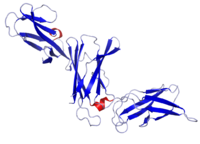Heterodimeric cytokine acting as mediator of inflammation
Interleukin 23 (IL-23) is a heterodimeric cytokine composed of an IL-12B (IL-12p40) subunit (which is shared with IL-12) and an IL-23A (IL-23p19) subunit.[1] IL-23 is part of the IL-12 family of cytokines.[2] The functional receptor for IL-23 (the IL-23 receptor) consists of a heterodimer between IL-12Rβ1 and IL-23R.[3]
- ^ Oppmann B, Lesley R, Blom B, Timans JC, Xu Y, Hunte B, et al. (November 2000). "Novel p19 protein engages IL-12p40 to form a cytokine, IL-23, with biological activities similar as well as distinct from IL-12". Immunity. 13 (5): 715–25. doi:10.1016/S1074-7613(00)00070-4. PMID 11114383.
- ^ Cauli A, Piga M, Floris A, Mathieu A (2015-10-01). "Current perspective on the role of the interleukin-23/interleukin-17 axis in inflammation and disease (chronic arthritis and psoriasis)". ImmunoTargets and Therapy. 4: 185–90. doi:10.2147/ITT.S62870. PMC 4918258. PMID 27471723.
- ^ Parham C, Chirica M, Timans J, Vaisberg E, Travis M, Cheung J, et al. (June 2002). "A receptor for the heterodimeric cytokine IL-23 is composed of IL-12Rbeta1 and a novel cytokine receptor subunit, IL-23R". Journal of Immunology. 168 (11): 5699–708. doi:10.4049/jimmunol.168.11.5699. PMID 12023369.
